The High Highs and Low Lows of Legal Regulatory Reform
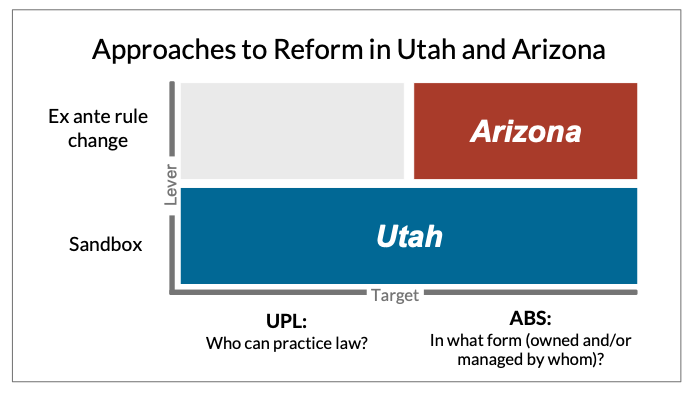
In the long run, however, it’s all about the data. Initial findings from Utah and Arizona reform efforts.
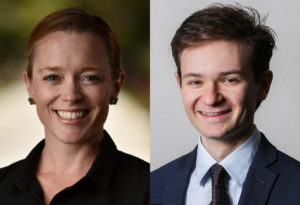
The year 2020, known to most for global pandemic shutdowns, also heralded leaps and bounds in legal regulatory reforms. Utah and Arizona approved extraordinary changes to the regulation of legal practice. Both states loosened the bans on nonlawyer ownership of legal practices and the practice of law by nonlawyers. Further, the Conference of Chief Justices issued a resolution urging states to consider regulatory innovations regarding the delivery of legal services, and the ABA approved a limited resolution encouraging consideration of regulatory innovation. Even Justice Neil Gorsuch weighed in with his support for regulatory innovation.
This year, on the other hand, has been more challenging. California’s Closing the Justice Gap Working Group, of which one of us (Lucy Ricca) was a member, was tasked with drafting a report to the State Bar’s Board of Trustees on what a California regulatory sandbox might look like. But the group became a punching bag of several of its own lawyer members as well as powerful members of the state legislature. The group was finally shuttered this past summer when those legislators forbade the Bar, or any group formed by the Bar, to work on anything having to do with reform of ownership or unauthorized practice rules. See Joyce E. Cutler, “California Restrains State Bar From Expanding Nonlawyer Practice,” Bloomberg Law, Sept 19, 2022. The ban also stopped any further work on paraprofessional licensing, a subject already addressed by a different working group that had completed and submitted its report.
Regulatory reform hit snags nationally, too. At its summer meeting, the ABA House of Delegates passed a non-binding resolution discouraging states from considering changes to the rules around nonlawyer ownership and investment. See “ABA Sides Against Opening Law Firms Up to New Competition,” Bloomberg Law, Aug 9, 2022. Although other states, including Washington and Michigan, continue to consider regulatory solutions to the justice gap, the once-substantial momentum for legal services reform seems to have stalled.
While the debates around legal regulatory reform and market liberalization continue, actual reforms proceed in Arizona and Utah. The Grand Canyon State abolished Professional Conduct Rule 5.4, allowing nonlawyers to own law firms and manage lawyers. See Robert Ambrogi, “Arizona Is First State To Eliminate Ban On Nonlawyer Ownership Of Law Firms,” LawSites, Aug 31, 2020.
Utah, by contrast, has launched a regulatory “sandbox”—or controlled policy program—in which state regulators permit designated legal entities to allow non-lawyers to practice law or to own law firms. In both states, new legal service providers are emerging. See “Enter the Sandbox: Utah’s bold new experiment in lawyer regulation,” The Practice (Jan/Feb 2021). These entities are partnering with or employing lawyers while offering new services to the public.
In our view, now is a good time to pause and ask, “What do Utah and Arizona teach us about the potential impacts of regulatory reform?” Some of the foundational questions include:
- What kinds of entities are entering the market?
- How are they structured?
- What services are they providing and to whom?
- Is there evidence of consumer harm?
New evidence from new reforms
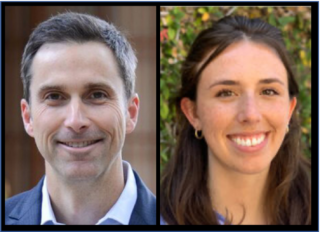
These are the questions driving a new report, “Legal Innovation After Reform: Evidence from Regulatory Change,” just released by the Deborah L. Rhode Center on the Legal Profession. This report, which we co-authored with Stanford Law Professor David Freeman Engstrom and current 3L Madeline Walsh, presents the first comprehensive study of the legal innovations emerging in Utah and Arizona post-reform.
We conducted the research as part of a policy lab at the law school—a small seminar in which students conduct research on policy questions for real-world clients. In this case, our “client” was the Regulation and Practice Reform Committee of the Michigan Justice for All Commission, co-chaired by Michigan Supreme Court Justice Brian Zahra and former Michigan Bar President Janet Welch.
To begin to answer the questions raised above, we looked at two types of data. First, to understand what types of innovation are possible, we conducted in-depth, semi-structured interviews with 37 entities that have obtained authorization in liberalizing jurisdictions, half in Utah and Arizona and half in the U.K., where reform efforts are more mature. Second, to understand how much innovation may result in U.S. legal markets, and whom it may serve, we conducted a comprehensive analysis of the application, authorization, and other public-facing materials from all 57 of the authorized entities in Utah and Arizona as of June 30, 2022.
Our review led to several key insights and a more detailed understanding of what newly authorized legal service providers are doing in both Utah and Arizona.
Toward a taxonomy of innovation
We found that regulatory reforms are spurring substantial innovation in five different ways, particularly in the ownership structure of providers and in their service delivery models. In particular, we have identified five innovation types: (1) traditional law firms making changes to their capital or business structure or service model; (2) “law companies” practicing law; (3) “non-law companies” as new entrants to the legal sector; (4) intermediary platforms; and (5) entities using nonlawyers and technology to practice law.
The first four categories involve business structure reforms and are mutually exclusive, though there are entities moving from one category to another (e.g., from firm to law company or from law company to non-law company). As shown in the below graphic, however, the fifth category is a little different.
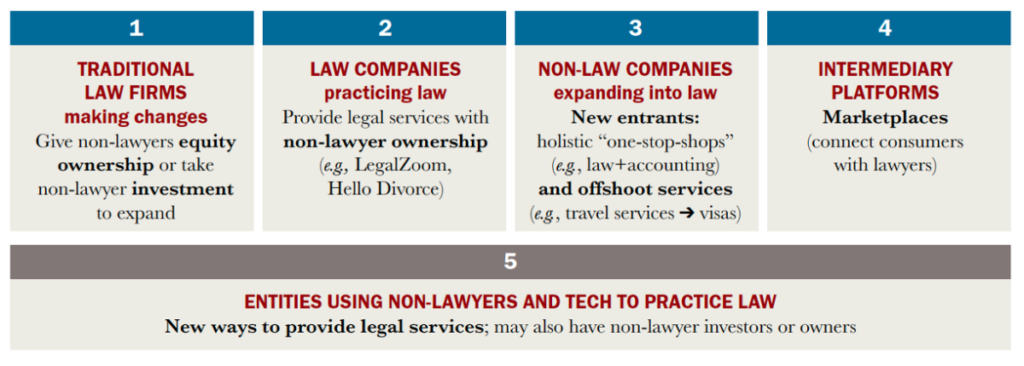
This last category (type 5) captures entities that are implementing service model innovations through the use of non-lawyers and software in order to practice law. This innovation, which is new to the U.S. legal landscape, is available only to entities authorized through the Utah sandbox.
Note that it’s possible that the entrant to the type 5 category may also be in one of the other four categories. For example, LawGeex is a law company (type 2) authorized in the Utah sandbox which is also authorized to use software to offer legal advice and guided assistance to its users (type 5).
As noted in today’s lead graphic, Arizona has limited its legal regulatory reform to alternative business structures (ABS). In contrast, Utah’s regulatory sandbox contemplates changes to the unauthorized practice of law (UPL).
Using our five-factor taxonomy, the graphic below summarizes the number of new entrants in both Utah and Arizona:

These categories show the kinds of innovations that may emerge as jurisdictions liberalize legal regulation.
- Traditional firms. Traditional firms make up 35% of authorized entities across Utah and Arizona. At this early stage, the traditional outlets are all local Utah and Arizona firms taking outside investment or non-lawyer owners. Their reasons range and include recognizing and retaining nonlawyer staff and raising capital to invest in technology or marketing.
- Law companies. Like traditional firms, law companies make up 35% of authorized entities in Utah and Arizona. Law companies include several familiar names: Rocket Lawyer, Legalzoom, Axiom, Elevate, Hello Divorce, and LawGeex. Each of these companies has chosen to become regulated in order to hire lawyers to practice law. This perhaps anodyne observation highlights the potential for regulatory reform to create new opportunities for lawyers to practice law for the public as salaried employees of established companies. Regulatory reform, in other words, has the potential not to replace lawyers with artificial intelligence or algorithms but to enable them to focus on what they are good at—the practice of law.
- Non-law Companies. 18% of entities are non-law companies—that is, new entrants to legal markets that have set up “one-stop shops” combining law and non-law expertise or, alternatively, have begun to offer legal services as an adjunct to their primary line of business. One-stop shops are often partnerships between lawyers and other professionals, such as accountants or financial advisers, and offer holistic, multi-professional solutions for their consumers. Companies moving into law from outside of the legal services industry include Law on Call, which is the new legal subsidiary of a registered agent company authorized in the Utah sandbox.
- Intermediary Platforms. Intermediary platforms are familiar offerings to the general legal industry. These marketplace companies connect lawyers to potential consumers, either through direct referral fee arrangements if permitted or through a workaround as a marketing vendor. The three intermediaries are authorized in the Utah sandbox primarily to enable the direct referral fee arrangement. One of these is Off the Record, the well-known traffic ticket marketplace.
- Entities Using Non-Lawyers to Practice Law. As mentioned, the final category captures entities building innovative service models around the unauthorized practice of law (UPL) waivers available in the Utah sandbox. These include traditional firms (e.g., 1LAW, law companies (e.g., Estate Guru), and non-law companies (e.g., Law-on-Call). Also included are entities primarily targeting low-income and indigent people, including all the nonprofit, community-based organizations. One example is Rasa, a B-corporation that uses both AI-enabled software and nonlawyer providers first to help Utahns determine whether they are eligible to expunge their criminal records and then to execute the expungement process. Rasa was recently named the winner of the Access to Justice Tech award at the American Legal Technology Awards.
The big picture: key takeaways
Our survey of these service providers yields several insights.
First, lawyers are central to the work of these new entities and to the innovation taking place within them. Lawyers are conceptualizing innovative ideas and driving their development. Lawyers are participating as owners, investors, compliance officers, supervisors, and providers. Lawyers are overseeing development and training, even where the entity’s primary innovation is using software or nonlawyers to provide service.
Second, most entities across both Utah and Arizona are implementing both technological and other innovations—such as price innovations—to deliver legal services in new ways. Crucially, the primary market appears to be individual consumers and small businesses. Although there are a few entities primarily serving large corporations (e.g., Axiom and Elevate), the strong majority are serving what Bill Henderson has labeled the PeopleLaw market. This is an exciting development since we know the PeopleLaw sector has experienced significant stress and decline within the traditional regulatory landscape. See, e.g., Post 287 (collecting data on five decades of PeopleLaw decline); Post 198 (discussing need in Pennsylvania); Post 042 (showing shrinking wallet share of legal services in typical US households): Post 039 (discussing decline of PeopleLaw, including findings of Chicago Lawyers I and II studies).
Below is a breakdown by client type and jurisdiction:

As summarized in the graphic below, the Utah sandbox entities and Arizona ABSs have sought authorization to offer services across a wide variety of substantive legal areas:
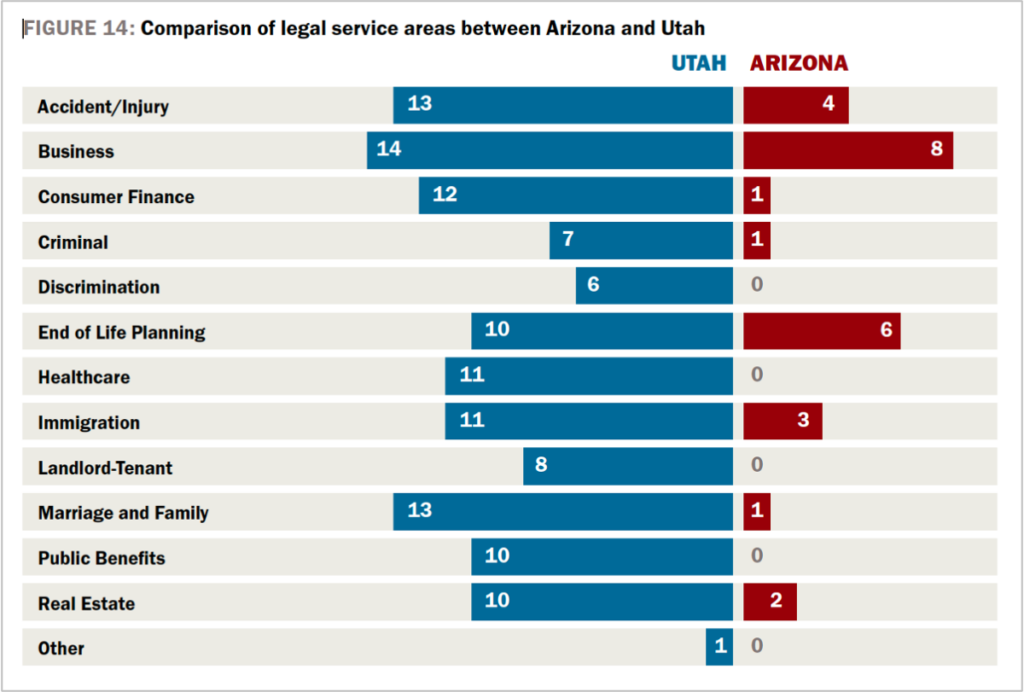
A third takeaway is that addressing UPL within the reform agenda appears to be critical, at least at this stage, to serving lower-income populations. Utah offers UPL waivers to entities seeking to use software or nonlawyers to practice law under the entity’s license. Arizona’s reforms, in contrast, are directed at entities seeking to access non-lawyer ownership or investment. It’s noteworthy that the Utah sandbox contains the only entities—all of them non-profits—that report serving primarily serve indigent and low-income people.
Finally, reform efforts to this point do not appear to pose a substantial risk of consumer harm. Data and information reported by Utah and Arizona regulators indicate that authorized entities do not appear to draw a substantially higher number of consumer complaints, as compared to their lawyer counterparts. For instance, Utah’s June 2022 data reported one complaint per 2,123 services delivered, and Arizona has received no complaints. This is generally on par with the number of complaints lodged against lawyers.
Moving past the low lows
The above lessons have important implications for the future of regulatory reform, a movement that remains as urgent as ever.
Political setbacks in California and elsewhere force proponents of reform to make the case, once again, for why reform matters at all. The case is not hard to make: This country’s access-to-justice crisis continues to get worse by the year. The crisis is caused, in part, by the dysfunctional market for legal services instituted and upheld by regulations protecting lawyers from competition and innovation in the modern economy.
Opponents of reform stand by their usual arguments: allowing nonlawyer ownership or practice will undermine the ethical values and independence of the legal profession and result in lower quality legal services, leading to potentially significant consumer and societal harm, or that increased market liberalization will ultimately exacerbate the existing inequalities in access to justice.
Much about regulatory reform remains untested and unknown. But our report finds that at least some evidence does not support several doomsday predictions from reform’s opponents. See, e.g., Sherry Levin Wallach, “Why Lawyers Reject Non-Attorney Firm Ownership,” Bloomberg Law, Sept 30, 2022 (President of NYSA arguing, without evidence, that new entrants in Utah and Arizona are drawn only to lucrative areas of law already amply served by lawyers).
But more to the point, the status quo is not cost-free. The current system creates active and unaddressed harms to tens of millions of Americans who are priced out of the market altogether and never seek help for their legal problems, or who could represent themselves ably but are too discouraged or disillusioned to try. Lawyers like to think of themselves as problem-solvers. But too many lawyers seem unwilling to remove the barriers that block access to legal solutions.
At long last, it’s time to try. It’s heartening to see progress in Utah and Arizona. More data is sure to embolden other jurisdictions.
This essay was first published by Legal Evolution on October 16, 2022. Read the complete article here.
Lucy Ricca and Graham Ambrose, two of the authors of the recently published Stanford Law report on the legal regulatory changes taking place in Utah and Arizona. Ricca is the Director of Policy and Programs at the Deborah L. Rhode Center on the Legal Profession and was the founding Executive Director of the Office of Legal Services Innovation (the regulatory office overseeing the Utah sandbox). In addition, she remains a member of the Office’s Executive Committee. Ambrose is currently a 2L at Stanford Law and a 2022-23 Civil Justice Fellow at the Rhode Center.
